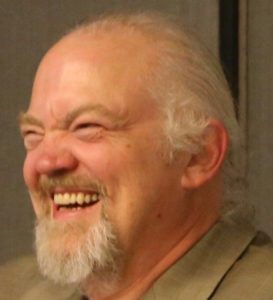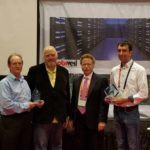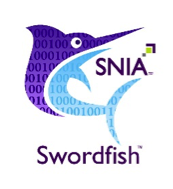 The Storage Networking Industry Association’s (SNIA’s) Storage Management Initiative (SMI) took on the topic of SNIA Swordfish
The Storage Networking Industry Association’s (SNIA’s) Storage Management Initiative (SMI) took on the topic of SNIA Swordfish in a live webcast titled “Introduction to SNIA Swordfish
in a live webcast titled “Introduction to SNIA Swordfish – Scalable Storage Management.” The replay is available here. SNIA experts Richelle Ahlvers and Don Deel, responded to questions during the webcast. Here are those questions and responses:
– Scalable Storage Management.” The replay is available here. SNIA experts Richelle Ahlvers and Don Deel, responded to questions during the webcast. Here are those questions and responses:
Q. You talked about two different ways to add storage to Redfish – hosted service configuration and integrated service configuration. When would you use one configuration instead of the other?
A. The integrated services configuration was added to clarify support with direct attach configurations using Swordfish constructs. If you have a server that has a RAID card in it, and you want to have it use a more complex storage configuration – storage pools and some notion of class of service, you would use the integrated service configuration. The hosted service configuration is used to model non-direct attach configurations, such as external storage arrays, or file services.
Q. Another service configuration question. For a pure JBOD, which would be the preferred approach?
A. A JBOD configuration configuration could start with either configuration depending on whether it is a standalone system (HSC) or server-attached. If the JBOD has an embedded controller in an enclosure, it could be modeled using the HSC configuration.
Q. Are there provisions for adding custom data in the payloads that Swordfish support. Is there a method to add vendor specific parameters in the payload?
A. Previous standards did not have a good model for adding OEM specific data.
As a result, Redfish, and its extensions such as Swordfish, have ensured that there is a very clean place to add OEM data. Every schema supports OEM extensions in two places. There are OEM extensions for properties and also for OEM actions – a way to support functions that don’t map to REST.
Q. Is there any work related to NVMe over Fabric in development?
A. Both SNIA and the Distributed Management Task Force (DMTF – which developed Redfish) have been working on this. The DMTF’s Redfish Forum developed the base model for SAS/SATA and PCIe fabrics, which is being extended to include NVMe over Fabric. SNIA is also working on adding NVMe over Fabric device connections to their basic models to integrate the storage elements.
Q. I think of Redfish as talking to the Baseboard Management Controller (BMC). Where is Swordfish functionality located? Is it on the CPU running the OS or is it also out of band?
A. Where Swordfish is running will be determined by the implementation. An implementation can choose to run either in band or out of band. In most cases this will be consistent with implementations. If a vendor’s existing architecture supports out of band management, then their Swordfish implementation will also likely be out of band. Note that the Swordfish implementation may leverage existing Redfish instrumentation on integrated components in either case, but this is a completely vendor-specific choice.
Q. What is meant by endpoint?
A. Endpoints are an abstraction of a connection. They describe the connections without needing to define everything about the underlying hardware.
Q. Since JBODs fall within the domain of server hardware, can software RAID solutions take full advantage of Swordfish?
A. The software RAID solutions can absolutely take full advantage of Swordfish. Remember that Swordfish is a schema extension to Redfish for storage functionality; therefore, it doesn’t care what underlying hardware it is running on. Note that many different types of storage solutions today run on “server hardware” – SDS solutions, for example, have no custom hardware, and fall exclusively in this domain, yet are clearly storage solutions.
Q. Is Swordfish planning on staying an extension to Redfish? Does it have a goal of being integrated into Redfish specification at some point?
A. Yes, Swordfish plans to remain an extension to Redfish. There isn’t a reason to integrate it into Redfish, as it is already tightly coupled with Redfish; the schema are delivered publicly on the same site. The SNIA will continue to own Swordfish content separately from DMTF in order to take advantage of the focused attention of the large body of storage domain experts in SNIA. In order to allow the Redfish ecosystem to grow to its maximum potential as quickly as possible, DMTF is partnering with other organizations to add features such as storage and networking to the standard.
Q. Do you have to be a SNIA member to contribute to the open source work?
A. No. You do not have to be a SNIA member to contribute to the open source projects. You will, however, need to sign the SNIA Contributor License Agreement, available at snia.org/cla in order to release any contributions you make to the open source projects to SNIA to allow us to incorporate them back into the open source projects.
Q. Going through the specs for Redfish /Swordfish, I can see that only a few parameters of the schema are really mandatory to be supported by the vendor. Does that not break functionality where a client would be expecting data as per the entire schema?
A. The SSM TWG is working on the development of feature profiles, which will help clarify which functionality is required to be implemented for specific clients, applications, and use cases. In addition to the functionality requirements in the Swordfish specification, the profile definitions will help clarify to both clients and service implementations much more clearly what functionality is required to implement for their specific configurations.
Additional information on SNIA Swordfish is available at: www.snia.org/swordfish. This site contains resources including the latest specification, a Swordfish User Guide, a Swordfish Practical Guide, Swordfish mockups and more.
You can also join the Redfish Specification Forum to ask and answer questions about Swordfish!
 SNIA On Storage is teaming up with the SNIA Technical Council to dive into major themes of the 2018 conference. The SNIA Technical Council takes a leadership role to develop the content for each SDC, so SNIA on Storage spoke with Mark Carlson, SNIA Technical Council Co-Chair and Principal Engineer, Industry Standards, Toshiba Memory America, to understand why SDC is bringing Computational Storage to conference attendees.
SNIA On Storage is teaming up with the SNIA Technical Council to dive into major themes of the 2018 conference. The SNIA Technical Council takes a leadership role to develop the content for each SDC, so SNIA on Storage spoke with Mark Carlson, SNIA Technical Council Co-Chair and Principal Engineer, Industry Standards, Toshiba Memory America, to understand why SDC is bringing Computational Storage to conference attendees. Regency Santa Clara CA. The
Regency Santa Clara CA. The  2018 conference. The SNIA Technical Council takes a leadership role to develop the content for each SDC, so SNIA on Storage spoke with Bill Martin, SNIA Technical Council Co-Chair and SSD I/O Standards at Samsung Electronics, to understand why SDC is bringing NVMe and NVMe-oF to conference attendees.
2018 conference. The SNIA Technical Council takes a leadership role to develop the content for each SDC, so SNIA on Storage spoke with Bill Martin, SNIA Technical Council Co-Chair and SSD I/O Standards at Samsung Electronics, to understand why SDC is bringing NVMe and NVMe-oF to conference attendees.


 NVMe over Fabrics high-performance storage software were recognized for creating an open storage management specification that works with EXTEN storage software for being the first in the industry to provide a solution based on
NVMe over Fabrics high-performance storage software were recognized for creating an open storage management specification that works with EXTEN storage software for being the first in the industry to provide a solution based on  The Storage Networking Industry Association’s (SNIA’s) Storage Management Initiative (SMI) took on the topic of SNIA Swordfish
The Storage Networking Industry Association’s (SNIA’s) Storage Management Initiative (SMI) took on the topic of SNIA Swordfish in a live webcast titled “
in a live webcast titled “ The Storage Networking Industry Association’s (SNIA’s) Storage Management Initiative (SMI) took on the topic of SNIA Swordfish
The Storage Networking Industry Association’s (SNIA’s) Storage Management Initiative (SMI) took on the topic of SNIA Swordfish in a live webcast titled “
in a live webcast titled “ The Storage Networking Industry Association’s (SNIA’s) Storage Management Initiative (SMI) took on the topic of SNIA Swordfish™ in a live webcast titled “
The Storage Networking Industry Association’s (SNIA’s) Storage Management Initiative (SMI) took on the topic of SNIA Swordfish™ in a live webcast titled “